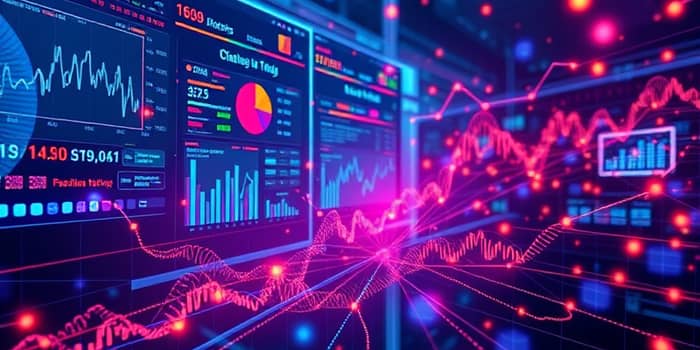In an age of unprecedented data velocity and market complexity, financial institutions and individual investors alike seek clarity and foresight. By harnessing cutting-edge digital tools, they can transform raw data into actionable insights, ensuring stronger performance, tighter compliance, and agile risk management.
This article explores the latest solutions, best practices, and emerging trends to help you build a robust monitoring framework and stay ahead in dynamic markets.
The Expanding Landscape of Market Monitoring
The global monitoring tools market is projected to soar to $63.7 billion by 2028, driven by giants such as Microsoft, Google, and AWS. Within this space, application metrics and monitoring tools are expected to grow from $12.88 billion in 2025 to $37.78 billion by 2035.
Factors fueling this expansion include:
- Cloud-native application adoption
- AI-based observability solutions
- Microservices, DevOps, and hybrid cloud deployments
- Edge computing and IoT integration
As environments become more distributed and complex, the need for real-time application performance monitoring and deep visibility across all layers of infrastructure has never been greater.
Key Categories of Financial Market Monitoring Tools
Modern solutions fall into several specialised categories, each addressing critical aspects of trading infrastructure, surveillance, and compliance.
Trade Infrastructure Monitoring Solutions
Ensuring low latency and high availability in trading environments is paramount. Leading providers include:
Over 90% of Tier 1 firms trust ITRS to detect and resolve anomalies before they impact trading flows, while Beeks leverages Grafana-powered dashboards for deep network traffic analysis.
Trade Surveillance and Compliance Tools
Detecting market abuse and ensuring regulatory compliance requires advanced analytics and historical data analysis:
- Nasdaq SMARTS: Real-time surveillance with flexible configurations
- Bloomberg Surveillance: Seamless integration with Bloomberg Terminal
These platforms employ machine learning to flag suspicious patterns, support investigation workflows, and generate audit-ready reports for compliance teams.
AML and Financial Crime Monitoring
Anti-money laundering (AML) and financial crime tools are undergoing a transformation through AI and behavioral analytics:
Dynamic, self-tuning models adapt in real time, refining risk rules as new threats emerge. With AI-driven risk scoring, financial institutions can reduce false positives by up to 45%, cutting operational costs by half.
Core Capabilities Powering Modern Monitoring
At the heart of every effective monitoring suite lie several indispensable capabilities:
- Real-time alerting and dashboards
- Anomaly detection through machine learning
- Predictive analytics for issue prevention
- Automated incident response workflows
These features enable institutions to track trading activities as they happen, receive immediate notifications for suspicious behavior, and initiate remediation processes without delay.
Implementation Best Practices
Deploying a robust monitoring framework requires careful planning across technology, risk, and regulatory domains.
Seamless Technology Integration
Ensure new tools integrate with existing platforms and data sources. Supporting hybrid architectures—on-premises, cloud, and edge—enables continuous observability and unified management.
Effective Risk Management
AI-driven tools introduce potential risks such as algorithmic bias, data quality issues, and model hallucination. Adopting governance frameworks and regular model audits can mitigate these concerns.
Regulatory Compliance Alignment
Tailor monitoring systems to meet jurisdiction-specific requirements. Automated reporting modules streamline submissions, while consumer protection analysis ensures vulnerable segments receive adequate oversight.
Emerging Trends Shaping the Future
As we look beyond 2025, several trends will redefine market monitoring:
- Proactive, pre-event monitoring to reduce downtime
- Convergence of observability with full-stack monitoring
- AI-powered anomaly detection with self-healing workflows
- Increased focus on digital services for financial inclusion
These developments underscore the shift from reactive incident response to predictive capabilities that identify risks earlier, safeguarding operations and reputations.
Conclusion: Building a Resilient Monitoring Ecosystem
In turbulent financial markets, effective monitoring is not a luxury—it’s a strategic imperative. By combining advanced tools, AI-driven analytics, and disciplined implementation practices, institutions can:
- Optimize trading performance and reduce latency
- Strengthen compliance and anti-fraud efforts
- Harness predictive insights for proactive risk mitigation
Embracing this holistic approach empowers organizations to navigate volatility with confidence, seize emerging opportunities, and deliver secure, compliant services that meet the demands of tomorrow’s markets.
References
- https://www.cgap.org/topics/collections/market-monitoring-tools
- https://www.globenewswire.com/news-release/2025/05/09/3078311/0/en/Monitoring-Tools-Market-Surges-to-63-7-billion-by-2028-Led-by-Microsoft-US-Google-US-AWS-US-IBM-US-Cisco-US.html
- https://a-teaminsight.com/blog/the-top-seven-trade-infrastructure-monitoring-solutions-in-2025/?brand=ati
- https://www.silenteight.com/blog/2025-trends-in-aml-and-financial-crime-compliance-a-data-centric-perspective-and-deep-dive-into-transaction-monitoring
- https://www.futuremarketinsights.com/reports/application-metrics-and-monitoring-tools-market
- https://snapinnovations.com/10-best-trade-surveillance-software-in-2024/
- https://www.ecb.europa.eu/press/financial-stability-publications/fsr/special/html/ecb.fsrart202405_02~58c3ce5246.en.html
- https://www.cgap.org/topics/collections/market-monitoring










